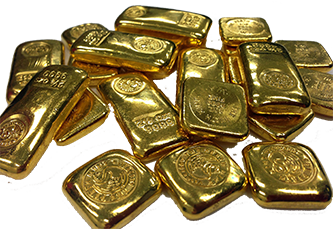

Welcome to the Weekend! The financial data indicates several noteworthy trends with implications for the dollar’s value and investment strategies. A high gold-to-silver ratio suggests that silver may be undervalued relative to gold while increasing US 10-year Bond Yields reflect market anticipation of Federal Reserve actions against inflation.
Essential commodities such as crude oil remain stable. Despite the current sell-down of Bitcoin’s price, the cryptocurrency market remains robust, suggesting continued interest in alternative investments. However, concerns over government spending, notably the projected increase in the national debt, could exert downward pressure on the dollar long term.
Detailed Financial Forecast and Analysis
Commodity Markets:
Gold: The price today was $2,328.46 per ounce. Gold remains a safe-haven asset, especially in times of economic uncertainty. Considering a potential 3-month forecast, geopolitical tensions and ongoing monetary policy adjustments will likely support gold prices, with a possible 3-5% increase if such conditions persist.
Silver: Trading at $31.2095 per ounce with a current gold-to-silver ratio (g/s) of ‘76.58’. This ratio implies that purchasing one ounce of gold requires 79.72 ounces of silver. Historically, the average g/s ratio has been between 8-16, indicating that silver might be undervalued or “on-sale” relative to gold. Over the next quarter, should investor sentiment turn towards undervalued assets, silver could see an uptick in demand, leading to a 5-8% price increase.
Palladium and Platinum: Current prices are $1060.98 and $1040.65, respectively. Both these commodities are essential in various industries such as automotive and electronics. Palladium, especially, has been volatile due to supply chain constraints. The forecast shows that these metals maintain or slightly increase their value by 1-4%, depending on production recovery and automotive industry demand.
Energy (Crude Oil): At $83.08 per barrel, the energy market shows moderate stability. Over the next three months, seasonal demand fluctuations and geopolitically driven supply disruptions could lead to increased volatility and a potential 2-6% increase in oil prices.
Copper: Copper’s price of $4.4255 indicates stable demand, especially given its role in infrastructure and electrification trends. Copper could see a 3-7% increase as global recovery efforts from the pandemic continue to drive demand for construction and electrical products.
Equity Markets:
US 10-Year Bond Yield: At 4.21%, the yield anticipates continued monetary tightening as the Fed combats inflation. High rates could negatively impact equities in the short term, but we see that heavy debt buying is done repeatedly against rising rates to keep rates down, at least until the election. Falling rates mean debt is being purchased in large quantities; expect to see equities benefit from massive further inflationary spending.
Bitcoin USD: Bitcoin’s price is below $60k for what I believe will be just a short period of time. As the Fed continues to pour inflationary debt spending into the financial system, investors’ appetite for digital assets as a hedge against traditional market volatility and inflationary pressures will likely increase with inflation. Bitcoin may sustain or improve its position by 10-20% in the next quarter, barring regulatory constraints.
Credit and Debt:
Credit Card Debt and Foreclosures: An uptick in credit card debt and any rise in foreclosures may negatively affect consumer spending and the broader economy. An estimated 5-10% rise in credit card debt would not be surprising, particularly as post-pandemic spending normalizes and interest rates rise.
Government Spending and National Debt: The Congressional Budget Office projections indicating the national debt could surpass $56 trillion over the next ten years are particularly concerning. This places significant depreciation pressure on the dollar. Investors should consider this when considering long-term holdings in USD-denominated assets.
Strategic Recommendations
– **Short-term (3 months)**: Investors might consider a defensive position by favoring gold, silver, and fixed-income securities like bonds, as inflationary and fiscal concerns loom.
Long-term: Moderate diversification into non-correlated assets, such as precious metals and certain cryptocurrencies, could provide a hedge against potential downturns in traditional markets. Caution is advised, as larger macroeconomic factors, including high levels of national debt, pose a threat to market stability.
Currency Outlook: The US dollar might face headwinds from high national debt levels and continued monetary policies aimed at inflation control. Investors should monitor the strength of the dollar regularly and consider potential safe-haven currencies or assets as part of their strategies.
Key Risks
Inflation: Continually monitoring inflation is necessary, as it will influence the Federal Reserve’s monetary policies and significantly impact bond yields and equity markets. We believe inflation will continue to rise as more pressure is put on the dollar through ‘easing’ efforts that attempt to keep interest rates down as long as possible.
Government Spending: Escalating government spending can accelerate inflation and weaken the dollar, prompting a shift to hard assets like gold or potentially non-traditional investments such as digital currencies.
Geopolitical Tensions: Global conflicts can swiftly change commodity prices and market sentiment. A robust risk management approach with stops and limits is advisable.
Be not deceived – be prepared ~ Silver Savior
WhySilverNOW.com (why is silver the most undervalued financial asset in the world)
Get Your Free Gold Wealth Kit Here
- Note: We are not giving advice; we only give our opinion; we are not financial advisors. This article only represents our thoughts about the economy.





